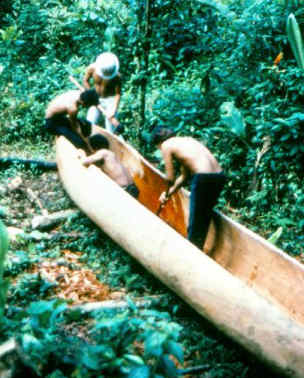Tree Trunk Canoe
Early boats of Antigua were hollowed out tree trunks and may have been given extra freeboard by adding planks on either side. Arawakan speaking Amerindians that appeared from South America made these boats. Firstly, a large tree was chosen and fire was set around the base to kill it. Then it was left standing for a year or so to season.
 A favorite boat-building village was probably on the hill east of Monk's Hill where the cell phone antenna is today. We know this because many conch-shell hand adzes, flint tools and pottery have been found at that spot. According to the missionaries, these adzes were used in conjunction with fire to hollow out the tree trunks. The trees were chosen from the interior of Antigua behind the hill, cut down and hollowed on the spot Then a team of men dragged the bare hull to the village for finishing.
A favorite boat-building village was probably on the hill east of Monk's Hill where the cell phone antenna is today. We know this because many conch-shell hand adzes, flint tools and pottery have been found at that spot. According to the missionaries, these adzes were used in conjunction with fire to hollow out the tree trunks. The trees were chosen from the interior of Antigua behind the hill, cut down and hollowed on the spot Then a team of men dragged the bare hull to the village for finishing.
It would have been an easy matter to take the Canoes to Falmouth Harbor, as the canoes were literally slipped down the side of the steep hill to the water for launching. Canoes were the automobiles of the early people. They were used for communications around the coasts, fishing and even inter-island trade, proof of which has been determined archaeologically.
The Origin Of Sail
It is thought sail was not used until after 1605. In this year, three Spanish Galleys were wrecked on Guadeloupe and the Caribs murdered all the crews. One friar, a certain Father Blasius from the Low Countries was spared as he had shown the Indians how to make sails out of the linen cloth that had been a part of the ships' cargo.
He showed them how to make a fore and aft spritsail (common in the Low Countries, the innovation pleased the Caribs as the sails had saved them much labor. Incidentally, Father Blasius made his escape by using one of his sails one night when he saw a British merchantman the "Henry Challons" approaching the lee of Guadeloupe. From that time on, sail was reported in the Caribbean in historical records, and until recently, the Carib Canoes of the Eastern Caribbean used the same sprit rig, utilizing flour sacks sewed together as sail cloth.
CARIB SEA LORE
Face from a Carib/French Dictionary published in 1660 by Father Breton. During canoe building, if a woman had touched the boat with but the end of her finger, the Caribs believed the canoe would split and be leaky.
- Master of the Canoe and the calabash bailer is almost the same as skipper bailed throughout the voyage.
- The word "to voyage" literally means "to loot on water" or to raid.
- The tiller was always left unworked or unfashioned, otherwise it would not guide the boat well at sea.
- The crew sometimes wore a woven hat of cachibou leaves called a bakoua to protect from the sun and sea.
- The Caribs had a word which meant, "I wish the wind and waves would push us from the stern!"
- When they saw a squall approaching, they would blow into their hands sayingPiom, meaning "Go far away!"
- At the end of a voyage, the canoe was pulled up on rollers and the word is the same as horse, cart, and wheels. It even alluded to women as they make men "go along".
 Skip Nav
Skip Nav